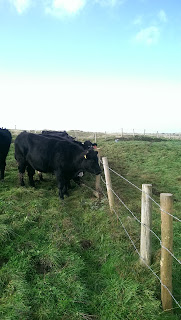Morfa Berwig was due a visit this morning, so I trundled along with the weather overcast but dry with some sunny spells.
The first thing I noticed as I approached the entrance were two new signs, it looks like the environmental enforcement team are getting as fed up with the fly tipping at the reserve as we are, well done..... We do have some Welsh Government signs to go up to reinforce the penalties of fly tipping.
A leisurely walk around the reserve accompanied by the sound of the birds in the trees and ditches, with Moorhen, Water Rail, a tit flock and a new bird for the site a Green Woodpecker, one or two flowers are still out including Marsh Ragwort; butterflies were represented by Red Admiral and Speckled Wood.
There are one or two decent sized Oaks on the reserve and I was drawn to one particular tree which seemed to have more galls than acorns.
 |
| Oak Marble Galls |
The galls,in this case Oak marble galls, are caused by a chemically induced distortion of leafbuds, caused by the gall wasp Andricus kollari . The wasp is not a native to the UK having been introduced from the Eastern Mediterranean in the 1800's for the tannin properties found in the gall.
 |
| Andricus kollari, 1.5 - 2 mm |
The marble gall has alternating sexual and asexual generations, often taking two years to complete, especially in the north of Britain. The familiar summer gall develops from eggs laid by a sexual female in the developing buds of the two native oaks in May or June; the host trees often being immature or retarded, scrub-oak, specimens; they are rarer on older healthy trees.
The developing spherical galls are green at first, brown later, and mature in August. Each gall contains a central chamber, with a single female wasp larva of the asexual generation, which emerges through a 'woodworm-like' hole as an adult winged gall-wasp in September. These asexual (agamic) females lay unfertilized eggs in the embryonic bud leaves of the Turkey oak, with galls slowly developing during winter, and are visible in March and April as small oval structures between the bud scales, looking like ant's eggs or pupae. The emerging adult gall-wasps in spring are the sexual generation, producing both males and females, which fly to the common oaks to initiate the formation of the summer marble gall.
The abnormal buds develop during summer and the bud is wholly replaced by the gall growth. Marble galls may remain attached to the tree for several years. The level of attack by the insect varies greatly from year to year. [source- Wikipedia]
 |
| exit hole.... |
Fascinating this nature stuff.
The recent rains have raised the levels of water across the site and its starting to take on its mantle as a wetland site, its worth a visit at anytime just to see how nature given time will heal the land.
























